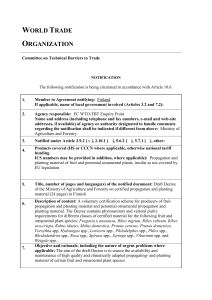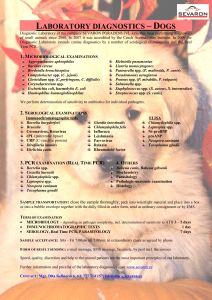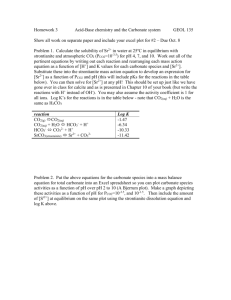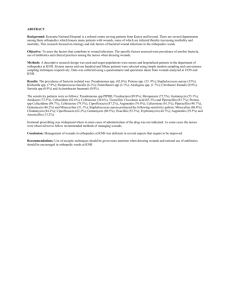Assiut university researches Epidemiological studies on zoonotic
advertisement
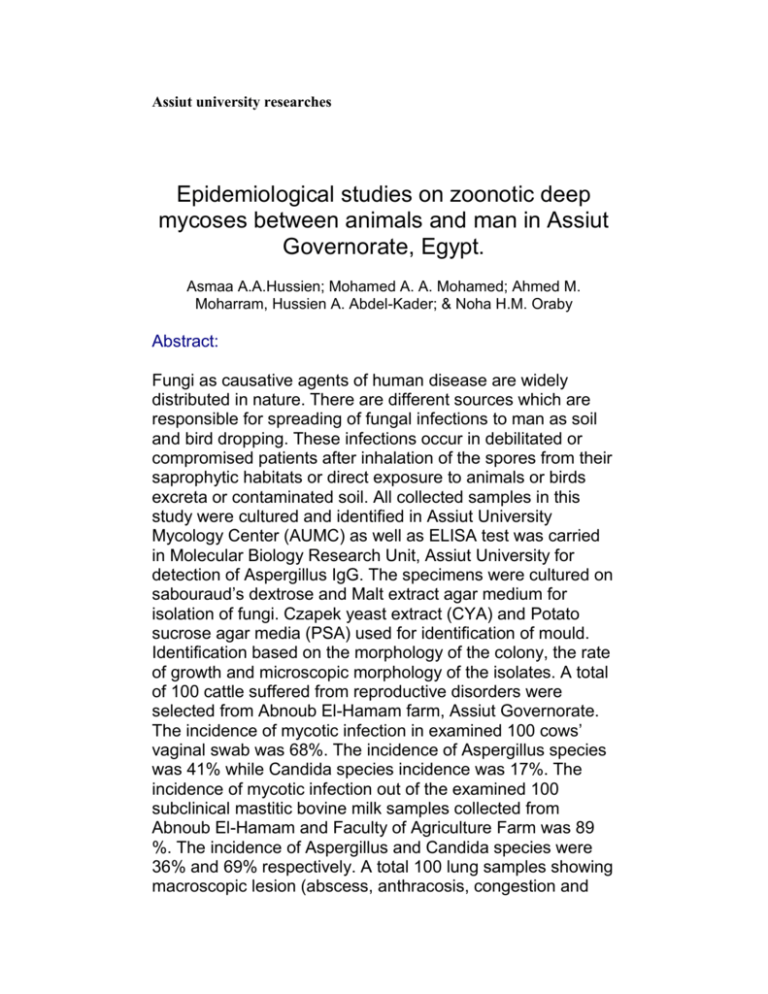
Assiut university researches Epidemiological studies on zoonotic deep mycoses between animals and man in Assiut Governorate, Egypt. Asmaa A.A.Hussien; Mohamed A. A. Mohamed; Ahmed M. Moharram, Hussien A. Abdel-Kader; & Noha H.M. Oraby Abstract: Fungi as causative agents of human disease are widely distributed in nature. There are different sources which are responsible for spreading of fungal infections to man as soil and bird dropping. These infections occur in debilitated or compromised patients after inhalation of the spores from their saprophytic habitats or direct exposure to animals or birds excreta or contaminated soil. All collected samples in this study were cultured and identified in Assiut University Mycology Center (AUMC) as well as ELISA test was carried in Molecular Biology Research Unit, Assiut University for detection of Aspergillus IgG. The specimens were cultured on sabouraud’s dextrose and Malt extract agar medium for isolation of fungi. Czapek yeast extract (CYA) and Potato sucrose agar media (PSA) used for identification of mould. Identification based on the morphology of the colony, the rate of growth and microscopic morphology of the isolates. A total of 100 cattle suffered from reproductive disorders were selected from Abnoub El-Hamam farm, Assiut Governorate. The incidence of mycotic infection in examined 100 cows’ vaginal swab was 68%. The incidence of Aspergillus species was 41% while Candida species incidence was 17%. The incidence of mycotic infection out of the examined 100 subclinical mastitic bovine milk samples collected from Abnoub El-Hamam and Faculty of Agriculture Farm was 89 %. The incidence of Aspergillus and Candida species were 36% and 69% respectively. A total 100 lung samples showing macroscopic lesion (abscess, anthracosis, congestion and area of hepatizition) were collected from slaughter houses in Assiut Governorate. The incidence of mycotic infection in 100 examined bovine lung samples was 91%. Mycotic infection was recorded in different localities as 100%, 92%, 87.1% and 83.3% in Mosha, El-Mateaa, Manqabad and Abnoub localities respectively. The incidence of Aspergillus spp. and Candida spp. in the examined bovine lung samples was 81% and 27% respectively. A total of 44 mould species were isolated from soil samples collected from different localities in Assiut Governorate. The isolated fungi were Aspergillus spp, Pencillium spp, Fusarium.spp , Alternaria alternate; Eurotium amstelodami; Trichoderma harzianum ; Emercilla nidulans; Mucor spp.; Circenella muscae; Cunninghamella echinulata; Syncephalastrum racemosum; Humicola rugosa; Cladosporium spp; Acremonium strictum; Myrothecium verrucaria; Setosphaeria rostrata; Gliocladium spp; Talaromyces stipitatus; Monodyctis castanea Scopulariopsis brumpti; Sporothrix inflata and Stachybotrys chartum . The most common fungal isolates obtained from 93 out of 100 examined bird dropping samples were Aspergillus spp.; Pencillium spp; Fusarium.spp; Alternaria alternate ; Eurotium amstelodami ; Trichoderma harzianum ; Mucor spp.; Helicostylum piriformis ;Syncephalastrum racemosum; Humicola rugosa ; Cladosporium spp.; Setosphaeria rostrata ; Scopulariopsis brumpti; Candida spp.and Trichosporon spp. The incidence of pulmonary fungal infection in 100 examined sputum samples from patient admitted in Chest hospital was 97%. The incidence of Aspergillosis in human patients was 88%. The higher incidence was recorded among male patients (89.4%) comparing with female patients (85.3%). 36.4 % of Aspergillus positive patient were suffered from T.B., 26.1% from bronchial asthma, 22.7 % from bronchitis & chest pain and 14.8% from pneumonia. Incidence of Aspergillus fumigatus by using culture method and ELISA IgG were 16 % and14% respectively. Concerning to Candidiasis, the incidence rate was 58% out of 100 examined patient sputum samples. The rate of infection among male and female was 59.1 %, and 55.9 % respectively. Intensification of the infection (74.4%) among the age group 31- 50 years was discussed. This study clarified that 38% of Candida positive patient were suffered from bronchial asthma, 24.1% from T.B., 20.7 % from bronchitis & chest pain and 17.2 % from pneumonia. A total of 11 CSF samples were collected from patients admitted to Assiut University Hospitals, Psychic and Neurology Department. Candida tropicalis was isolated from two patients [one from male, 42 years old age and the other from a female, 35 years old age with]. In our study, we found that animal play an important role in the epidemiology of human mycoses either as a vector of pathogenic fungi or as a creator of environmental prerequisites for the development of fungi. The combination of culture method and ELISA can be ideal to confirm the diagnoses of mycoses especially in immunocompromised patients. Also, in cases of recurrent encephalitis, investigation should include examination for fungi in CSF. Published in: ال مؤت مر ال خامس ع شر ل جم ع ية صحة ال ح يوان وال محاف ظة ع لى االن تاج ,,ال ح يوان ى




